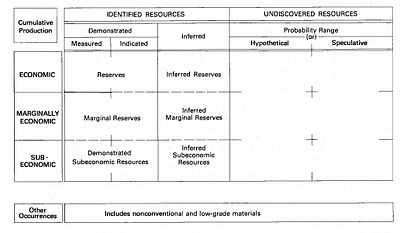Mineral resource classification
Mineral resource classification is the classification of mineral deposits based on their geologic certainty and economic value.

Mineral deposits can be classified as:
- Mineral resources that are potentially valuable, and for which reasonable prospects exist for eventual economic extraction.
- Mineral reserves or Ore reserves that are valuable and legally and economically and technically feasible to extract
In common mining terminology, an "ore deposit" by definition must have an 'ore reserve', and may or may not have additional 'resources'.
Classification, because it is an economic function, is governed by statutes, regulations and industry best practice norms. There are several classification schemes worldwide, however the Canadian CIM classification (see NI 43-101), the Australasian Joint Ore Reserves Committee Code (JORC Code), the South African Code for the Reporting of Mineral Resources and Mineral Reserves (SAMREC)[2] and the “chessboard” classification scheme of mineral deposits by H. G. Dill[3] are the general standards.
Mineral resources
A 'Mineral Resource' is a concentration or occurrence of material of intrinsic economic interest in or on the earth's crust in such form, quality and quantity that there are reasonable prospects for eventual economic extraction. Mineral Resources are further sub-divided, in order of increasing geological confidence, into inferred, Indicated and measured Categories.
Inferred Mineral Resource is that part of a mineral resource for which tonnage, grade and mineral content can be estimated with a low level of confidence. It is inferred from geological evidence and assumed but not verified geological/or grade continuity. It is based on information gathered through appropriate techniques from location such as outcrops, trenches, pits, workings and drill holes which may be of limited or uncertain quality and reliability.
Indicated resources are simply economic mineral occurrences that have been sampled (from locations such as outcrops, trenches, pits and drillholes) to a point where an estimate has been made, at a reasonable level of confidence, of their contained metal, grade, tonnage, shape, densities, physical characteristics.[2]
Measured resources are indicated resources that have undergone enough further sampling that a 'competent person' (defined by the norms of the relevant mining code; usually a geologist) has declared them to be an acceptable estimate, at a high degree of confidence, of the grade, tonnage, shape, densities, physical characteristics and mineral content of the mineral occurrence.
Resources may also make up portions of a mineral deposit classified as a mineral reserve, but:
- Have not been sufficiently drilled out to qualify for Reserve status; or
- Have yet to meet all criteria for Reserve status[2]
Mineral reserves/Ore Reserves
Mineral reserves are resources known to be economically feasible for extraction. Reserves are either Probable Reserves or Proven Reserves.
A Probable Ore Reserve is the part of Indicated resources that can be mined in an economically viable fashion, and in some circumstances, a Measured Mineral Resource. It includes diluting material and allowances for losses which may occur when the material is mined. A Probable Ore Reserve has a lower level of confidence than a Proved Ore Reserve but is of sufficient quality to serve as the basis for decision on the development of deposit.
A Proven Ore Reserve is the part of Measured resources that can be mined in an economically viable fashion. It includes diluting materials and allowances for losses which occur when the material is mined.
A Proven Ore Reserve represents the highest confidence category of reserve estimate. The style of mineralization or other factors could mean that Proven Ore Reserves are not achievable in some deposits.
Generally the conversion of resources into reserves requires the application of various modifying factors, including:
- mining and geological factors, such as knowledge of the geology of the deposit sufficient that it is predictable and verifiable; extraction and mine plans based on ore models; quantification of geotechnical risk—basically, managing the geological faults, joints, and ground fractures so the mine does not collapse; and consideration of technical risk—essentially, statistical and variography to ensure the ore is sampled properly:
- metallurgical factors, including scrutiny of assay data to ensure accuracy of the information supplied by the laboratory—required because ore reserves are bankable. Essentially, once a deposit is elevated to reserve status, it is an economic entity and an asset upon which loans and equity can be drawn—generally to pay for its extraction at (hopefully) a profit;
- economic factors;
- environmental factors;
- marketing factors;
- legal factors;
- political factors;and
- social factors[2]
See also
References
- ↑ US Geological Survey, 1980, Principles of a Resource/Reserve classification for Minerals, Circular 831.
- ↑ 2.0 2.1 2.2 2.3 Staff (2012). "Home". SAMCODE - South African Mineral Codes. SAMCODE - South African Mineral Codes. Retrieved 27 May 2012.
- ↑ Dill, Harald G. (June 2010). "The "chessboard" classification scheme of mineral deposits: Mineralogy and geology from aluminum to zirconium". Earth-Science Reviews 100 (1-4): 1–420. doi:10.1016/j.earscirev.2009.10.011.
External links
- JORC Code
- University of Western Australia Mining Law Centre
- U.S. Geological Survey Circular 831, Principles of a Resource/Reserve Classification for Minerals
- Canadian Institute of Mining, Metallurgy and Petroleum - CIM Definition Standards - On Mineral Resources and Mineral Reserves (PDF Format)
- The Canadian Council of Professional Geoscientists CCPG
- NI 43-101 Guidelines
- The South African SAMVAL and SAMREC Codes